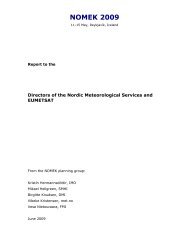International Symposium on Mitigative Measures against Snow ...
International Symposium on Mitigative Measures against Snow ...
International Symposium on Mitigative Measures against Snow ...
You also want an ePaper? Increase the reach of your titles
YUMPU automatically turns print PDFs into web optimized ePapers that Google loves.
<str<strong>on</strong>g>Internati<strong>on</strong>al</str<strong>on</strong>g> <str<strong>on</strong>g>Symposium</str<strong>on</strong>g> <strong>on</strong> <strong>Mitigative</strong> <strong>Measures</strong> <strong>against</strong> <strong>Snow</strong> Avalanches<br />
Egilsstaðir, Iceland, March 11–14, 2008<br />
2. PHYSICAL CONCEPT OF SNOW DRIFT<br />
<strong>Snow</strong> transport can be described as follows. If the wind shear exceeds a certain threshold<br />
grains will be entrained and set in moti<strong>on</strong>. The so called fluid threshold (for reference see<br />
Bagnold, 1941) is given by<br />
c<br />
e<br />
2 ( A ) ( ρ ρ ) gd<br />
.<br />
τ = −<br />
e<br />
ρP and ρa are the densities of the snow particles and air. Furthermore g denotes the standard<br />
accelerati<strong>on</strong> due to gravity, dP the snow particle diameter and Ae a dimensi<strong>on</strong>less empirical<br />
parameter, which is a functi<strong>on</strong> of the particle shape and particle cohesi<strong>on</strong>. The exact<br />
underlying mechanism which is resp<strong>on</strong>sible for the initiati<strong>on</strong> of the snow drift process is not<br />
completely known. Following Bagnold, Anders<strong>on</strong> and Haff (Anders<strong>on</strong> and Haff, 1991)<br />
estimated that the number of entrained grains per unit time and unit area depends linearly <strong>on</strong><br />
the excess shear stress<br />
∂N<br />
∂t<br />
e<br />
Schneiderbauer, Hinterberger, Fischer and Studeregger 75<br />
P<br />
a<br />
= ξ ( τ −τ<br />
),<br />
where τa denotes the air induced shear stress. ξ is an empirical c<strong>on</strong>stant with the dimensi<strong>on</strong>s<br />
of (force x time) −1 . The entrained particles are easily accelerated by the wind because of their<br />
small mass and diameter. Already entrained grains c<strong>on</strong>tribute to the wind shear, i.e. they<br />
reduce the threshold. In additi<strong>on</strong>, the wind influences the heights of the transport modes, e.g.<br />
the saltati<strong>on</strong> layer height increases with increasing wind speed (for reference see Owen,<br />
1964). Therefore, a higher amount of snow can be transported and more grains are entrained<br />
per unit of time. Due to the interacti<strong>on</strong> between grains and wind the wind field is modified.<br />
However, if the wind shear is below a sec<strong>on</strong>d threshold, the impact threshold, snow will be<br />
accumulated<br />
c<br />
a<br />
2 ( A ) ( ρ ρ ) gd<br />
,<br />
τ = −<br />
i<br />
i<br />
where Ai is again a dimensi<strong>on</strong>less empirical parameter. Grains whose moti<strong>on</strong> is directed<br />
towards the snow pack are deposited. The mass flux to the snow pack can be obtained by the<br />
change of volume fracti<strong>on</strong> of the snow in an arbitrary c<strong>on</strong>trol volume. The change of mass<br />
inside the c<strong>on</strong>trol volume has to be equal to the mass flux through the faces of the c<strong>on</strong>trol<br />
volume by the principle of mass c<strong>on</strong>servati<strong>on</strong>.<br />
Finally, it should be menti<strong>on</strong>ed that <strong>on</strong>ly a certain amount of grains can be transported by the<br />
wind. This leads to depositi<strong>on</strong> where the volume fracti<strong>on</strong> exceeds a third threshold, the<br />
saturati<strong>on</strong> volume fracti<strong>on</strong>. In all cases, gravity acts as a body force. Due to the slope angle of<br />
the snow pack the snow grains are affected by a downhill-slope force. Since the shear stress<br />
thresholds menti<strong>on</strong>ed above are <strong>on</strong>ly valid for flat plains a modificati<strong>on</strong>, which additi<strong>on</strong>ally<br />
incorporates the slope angle, is applied.<br />
The transport processes discussed above change the shape of the snow pack. In depositi<strong>on</strong><br />
z<strong>on</strong>es, the snow cover grows and thus the new shape influences the local velocity field. In<br />
additi<strong>on</strong>, in erosi<strong>on</strong> z<strong>on</strong>es a reversed process takes place. Hence, due to the modificati<strong>on</strong> of<br />
the wind field, the z<strong>on</strong>es change with time and depend <strong>on</strong> the shape of the snow pack.<br />
P<br />
c<br />
a<br />
e<br />
P<br />
P











